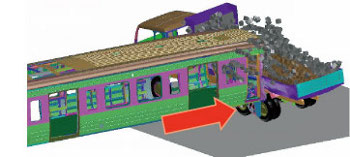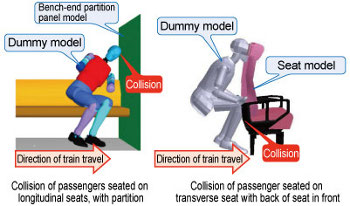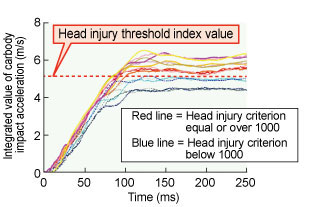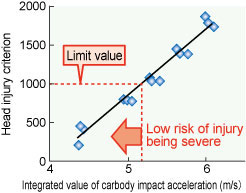8. Analytical method for evaluating carbody safety aimed at reducing passenger injury in case of level crossing collisions
Reducing passenger injury in case of a level crossing collision is a major issue. It is possible to calculate the carbody impact acceleration from analyses of train collisions with obstacles, however, it is difficult to evaluate injury to passengers. Therefore, in order to probe carbody impact acceleration inside a train in level crossing collision, impact analyses were conducted of a train colliding with a dump truck full of sand (overall weight 22 tonnes), using train speed as a parameter (30-130 km/h) (Figure 1).
The longitudinal carbody impact acceleration pulses obtained through these analyses were used as input for analysis of passenger behavior seated either on long seats or cross seats, which in turn were used to calculate an injury index (Figure 2). When the passenger injury index neared the limit level, the carbody impact accelerations were integrated as shown in Figure 3. This figure shows that there is a clear threshold which determines whether or not the injury index exceeds the limit level. The integrated acceleration value at the moment a passenger either collided with a partition wall or with the seat in front shows a close proportional relationship with the passenger injury index value (Figure 4).
The results of these investigations demonstrated that the integrated value of carbody impact acceleration was an effective index which could be used to reduce passenger injury. These results can also be used to establish carbody design guidelines to improve safety against collisions.
Other Contents
- 1. Seismic ground motion simulator applicable to M9 earthquakes
- 2. Seismic Hazard simulator for railways
- 3. Early warning system employing ocean bottom seismometer data
- 4. Development of Railway Embankment Structures Resistant to severe Earthquakes and Prolonged Overflows caused by Tsunamis
- 5. Measures against buckling of ballasted track during earthquakes
- 6. Disaster Hazard Mapping Technology
- 7. Method for diagnosing condition of concrete roadbed in tunnels
- 8. Analytical method for evaluating carbody safety aimed at reducing passenger injury in case of level crossing collisions
- 9. Bogie to control decrement in wheel load
- 10. Mechanical pneumatic steering system with failsafe function
- 11. Gear oil for Shinkansen trains with improved startability in low temperature conditions
- 12. Process to select appropriate sounds to convey in-cab driver alerts
- 13. Training in communication techniques for train dispatchers in disrupted situations
- 1. Seismic ground motion simulator applicable to M9 earthquakes
- 2. Seismic Hazard simulator for railways
- 3. Early warning system employing ocean bottom seismometer data
- 4. Development of Railway Embankment Structures Resistant to severe Earthquakes and Prolonged Overflows caused by Tsunamis
- 5. Measures against buckling of ballasted track during earthquakes
- 6. Disaster Hazard Mapping Technology
- 7. Method for diagnosing condition of concrete roadbed in tunnels
- 8. Analytical method for evaluating carbody safety aimed at reducing passenger injury in case of level crossing collisions
- 9. Bogie to control decrement in wheel load
- 10. Mechanical pneumatic steering system with failsafe function
- 11. Gear oil for Shinkansen trains with improved startability in low temperature conditions
- 12. Process to select appropriate sounds to convey in-cab driver alerts
- 13. Training in communication techniques for train dispatchers in disrupted situations




